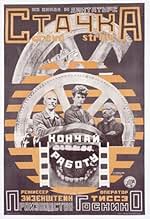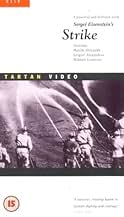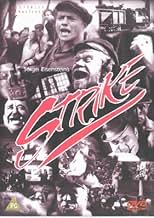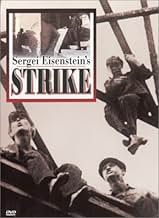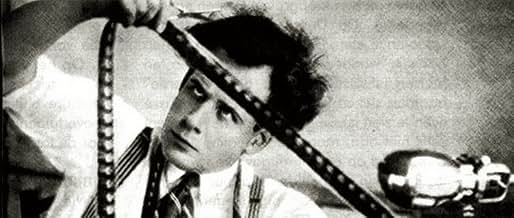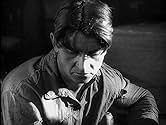IMDb रेटिंग
7.6/10
9.1 हज़ार
आपकी रेटिंग
अपनी भाषा में प्लॉट जोड़ेंA group of oppressed factory workers go on strike in pre-revolutionary Russia.A group of oppressed factory workers go on strike in pre-revolutionary Russia.A group of oppressed factory workers go on strike in pre-revolutionary Russia.
Leonid Alekseev
- Factory Sleuth
- (बिना क्रेडिट के)
Daniil Antonovich
- Worker
- (बिना क्रेडिट के)
Pyotr Malek
- Police Spy
- (बिना क्रेडिट के)
Misha Mamin
- Baby Boy
- (बिना क्रेडिट के)
Pavel Poltoratskiy
- Stockholder
- (बिना क्रेडिट के)
फ़ीचर्ड समीक्षाएं
Eisenstein's most purely enjoyable film, possibly because the theorems are more lifelike. In many ways a comedy, as the villains (military, police, factory owners, underworld scabs) are caricatured and dehumanised, which makes the eventual horrors all the more shocking. The workers are, of course, idealised, but their paradise of laziness seems odd for a Communist work.
Montage is the thing, as ever with Eisenstein, both in terms of connecting images to create startling insights, and in making tense, exciting and inevitable the action; but there is an astonishing attention to compositional detail too, most haunting perhaps being the empty, abandoned, impotent, machine-heavy factories, or the vast-stepped drawing rooms of the bloated capitalists.
Montage is the thing, as ever with Eisenstein, both in terms of connecting images to create startling insights, and in making tense, exciting and inevitable the action; but there is an astonishing attention to compositional detail too, most haunting perhaps being the empty, abandoned, impotent, machine-heavy factories, or the vast-stepped drawing rooms of the bloated capitalists.
Russian master Sergei Eisenstein's first feature film is a tour-de-force of cinematic technique. He appears to have a pretty speedy learning curve, beginning straight away with a picture that is confidently crafted and extremely watchable even today.
With the exception of Que Viva Mexico (which he made outside Russia), this is Eisenstein's purest film, the one most free from the constraints of the Bolshevik propaganda machine. There is one mention of the Bolsheviks, but it's inconsequential. This is essentially a film about self-organisation of the workers a placeless and timeless story which acts as a case study in how a strike can begin, how it can be made successful and how it can be defeated.
Strike has an incredibly exhilarating pace to it and, aside from its political message works as a pure action film. Perhaps unusually for a debut film, this is also the closest Eisenstein came to making a comedy. In a style that would mark all his films, he characterises the villains of the piece the factory management, police chiefs and government bureaucrats as exaggerated and often ridiculous figures of fun. The factory owner is the stereotypical capitalist a top hat-wearing fat controller.
As usual with early Soviet cinema, Strike is essentially characterless. The story is told through the masses, and the proletariat as a whole is the hero. Eisenstein was ideally suited to this, as even in this early film he gives an unprecedented realism to the crowd scenes, and uses every technique at his disposal to create drama from mass action. Eisenstein also demonstrates early on that he has the rather unusual talent of directing large groups of people being massacred. It's an image that would crop up in nearly all of his films.
The only real weakness of Strike is that it too often slips into pretentiousness. Some of the techniques are little more than showing off. There are just a few too many superimpositions and mirror images shots. The symbolism is also often a little too heavy-handed and abstract the two kids dancing on the table during the interrogation scene certainly baffles me; god knows what the Russian public made of it.
Eisenstein is often described as a pioneer, a founding father of film technique. However, in truth most of the techniques he used had been developed earlier, in particular by D.W. Griffith. It's just that Eisenstein pushed the possibilities of editing to their extreme. He's more of a maverick than a pioneer, as there really has been no-one like him since. Having said that, I can identify three new uses of the editing process that Eisenstein invented with Strike.
Firstly, he often uses a sequence of similar shots to give the impression of the same action being done by lots of people. For example, three shots of tools being thrown to the ground tells us quickly and effectively, in the context of the scene, that the entire workforce is downing tools. Secondly, he edits rhythmically to punctuate action. For example, a quick, dynamic action like someone throwing a punch or a door slamming shut will be punctuated by a film cut, giving it much more impact. This is particularly effective in silent film, as the jarring cuts mean you can almost hear the action in your head.
The third editing technique debuted here was the most abstract and the least influential. Whereas Griffith would edit back and forth between two or more literally related scenes (for example, between someone in trouble and someone coming to rescue them) to build up tension, Eisenstein edits back and forth between unrelated images to create a metaphor. The well-known example of this in Strike is the cutting from the workers being gunned down to shots of cattle being slaughtered the cattle dying is nothing to do with the plot, but it makes a point. It's a clever idea, but one that was rarely imitated as it breaks up the flow of a film's narrative.
On a totally different note, a little hobby of mine is spotting modern day look-alikes in old films, and Strike has one of my favourites. The king of the beggars is a dead ringer for Shane MacGowan, right down to the missing teeth. Amazing.
Strike has to be one of the most remarkable and mould-breaking debut films of all time. It's not quite up to the level of masterpiece yet, but it's an incredible experience and genuinely gripping entertainment.
With the exception of Que Viva Mexico (which he made outside Russia), this is Eisenstein's purest film, the one most free from the constraints of the Bolshevik propaganda machine. There is one mention of the Bolsheviks, but it's inconsequential. This is essentially a film about self-organisation of the workers a placeless and timeless story which acts as a case study in how a strike can begin, how it can be made successful and how it can be defeated.
Strike has an incredibly exhilarating pace to it and, aside from its political message works as a pure action film. Perhaps unusually for a debut film, this is also the closest Eisenstein came to making a comedy. In a style that would mark all his films, he characterises the villains of the piece the factory management, police chiefs and government bureaucrats as exaggerated and often ridiculous figures of fun. The factory owner is the stereotypical capitalist a top hat-wearing fat controller.
As usual with early Soviet cinema, Strike is essentially characterless. The story is told through the masses, and the proletariat as a whole is the hero. Eisenstein was ideally suited to this, as even in this early film he gives an unprecedented realism to the crowd scenes, and uses every technique at his disposal to create drama from mass action. Eisenstein also demonstrates early on that he has the rather unusual talent of directing large groups of people being massacred. It's an image that would crop up in nearly all of his films.
The only real weakness of Strike is that it too often slips into pretentiousness. Some of the techniques are little more than showing off. There are just a few too many superimpositions and mirror images shots. The symbolism is also often a little too heavy-handed and abstract the two kids dancing on the table during the interrogation scene certainly baffles me; god knows what the Russian public made of it.
Eisenstein is often described as a pioneer, a founding father of film technique. However, in truth most of the techniques he used had been developed earlier, in particular by D.W. Griffith. It's just that Eisenstein pushed the possibilities of editing to their extreme. He's more of a maverick than a pioneer, as there really has been no-one like him since. Having said that, I can identify three new uses of the editing process that Eisenstein invented with Strike.
Firstly, he often uses a sequence of similar shots to give the impression of the same action being done by lots of people. For example, three shots of tools being thrown to the ground tells us quickly and effectively, in the context of the scene, that the entire workforce is downing tools. Secondly, he edits rhythmically to punctuate action. For example, a quick, dynamic action like someone throwing a punch or a door slamming shut will be punctuated by a film cut, giving it much more impact. This is particularly effective in silent film, as the jarring cuts mean you can almost hear the action in your head.
The third editing technique debuted here was the most abstract and the least influential. Whereas Griffith would edit back and forth between two or more literally related scenes (for example, between someone in trouble and someone coming to rescue them) to build up tension, Eisenstein edits back and forth between unrelated images to create a metaphor. The well-known example of this in Strike is the cutting from the workers being gunned down to shots of cattle being slaughtered the cattle dying is nothing to do with the plot, but it makes a point. It's a clever idea, but one that was rarely imitated as it breaks up the flow of a film's narrative.
On a totally different note, a little hobby of mine is spotting modern day look-alikes in old films, and Strike has one of my favourites. The king of the beggars is a dead ringer for Shane MacGowan, right down to the missing teeth. Amazing.
Strike has to be one of the most remarkable and mould-breaking debut films of all time. It's not quite up to the level of masterpiece yet, but it's an incredible experience and genuinely gripping entertainment.
This is an impressive looking piece of Communists propaganda, that glorify the common worker, from Russian movie-making pioneer Sergei M. Eisenstein.
It's one of Eisenstein's first movies, which also means that he was experimenting a lot in the movie, with many different compositions and with fantastic fast editing that give the movie pace and make the sequences more exciting. Some of the sequences are highly creative and artistic looking, with great cinematography and camera-angels. It makes "Stachka" real eye-candy to watch. It's a real innovative movie and by watching it you realize that there was a real craftsman at work. It's an absolutely brilliantly directed movie!
Of course if you're looking for a movie with a good story and compelling characters, look further. The movie itself is pretty simple with its story and uses deliciously stereotypical characters, such as the capitalistic, fat, cigar smoking and drinking factory owners. The movie uses so many stereotypes that the movie intentionally also works out as an humorous movie. It's very welcome, since the movie in general in its story is very serious and tries to send out a message.
The story is perhaps easier to follow than in most other Eisenstein movies. It's a very simple story that on paper sounds to weak and uninteresting to fill a 90+ movie with. Yet the movie never bores and always remains interesting and 'enjoyable' to follow, also not in the least thanks to the rapid editing that makes sure none of the sequences go on for too long and allow the sequences to speak for itself, rather then relying on the actors their performances or title-cards.
An essential viewing for movie-lovers!
9/10
http://bobafett1138.blogspot.com/
It's one of Eisenstein's first movies, which also means that he was experimenting a lot in the movie, with many different compositions and with fantastic fast editing that give the movie pace and make the sequences more exciting. Some of the sequences are highly creative and artistic looking, with great cinematography and camera-angels. It makes "Stachka" real eye-candy to watch. It's a real innovative movie and by watching it you realize that there was a real craftsman at work. It's an absolutely brilliantly directed movie!
Of course if you're looking for a movie with a good story and compelling characters, look further. The movie itself is pretty simple with its story and uses deliciously stereotypical characters, such as the capitalistic, fat, cigar smoking and drinking factory owners. The movie uses so many stereotypes that the movie intentionally also works out as an humorous movie. It's very welcome, since the movie in general in its story is very serious and tries to send out a message.
The story is perhaps easier to follow than in most other Eisenstein movies. It's a very simple story that on paper sounds to weak and uninteresting to fill a 90+ movie with. Yet the movie never bores and always remains interesting and 'enjoyable' to follow, also not in the least thanks to the rapid editing that makes sure none of the sequences go on for too long and allow the sequences to speak for itself, rather then relying on the actors their performances or title-cards.
An essential viewing for movie-lovers!
9/10
http://bobafett1138.blogspot.com/
In the Soviet Union in 1903, the workers of a factory are tired of poor wages, hard living, and harsh treatment by their superiors. Talk of a strike is rife, and when one innocent worker is accused of theft, he hangs himself on the production line and unwittingly becomes a martyr. The strike is decided, and the workers gather in masses to discuss their terms. Meanwhile, the fat cats upstairs are in uproar that the strike has been called, and employ a number of secret agents with animal code names to infiltrate, brutalise and spy on the strikers. As the workers begin to fight amongst themselves, the bosses tactics become increasingly brutal, especially when the police are called in.
Sergei Eisenstein is one of the Soviet Union's greatest ever filmmakers, and arguably one the world's greatest. This was his first feature-length film (he made The Battleship Potemkin later that year, one of the best and most influential films ever made) and his trickery and style is awe- inspiring, given his inexperience and the fact that cinema was still in its early stages. The most effective technique Eisenstein plays is in the early scenes, where he juxtaposes different animals with the key players (Eisenstein was known as the 'King of Montage'). For example, there is an owl, always watching, thinking and cunning, turning into a wild-eye spy; a fox, misleadingly beautiful and sly, becoming a shapeshifting and handsome con-artist - and dancing bears, that portray the workers. The use of this is at its most powerful at the end, when the police move in to overthrow the strike, cut with scenes of a cow having its throat cut, blood gushing out of its wound as it slowly dies.
It's an incredibly stylish piece for its day and moves along at an alarming pace, even when compared to some films today. It never slows down to develop any characters, instead using its revolutionary and Communist themes to play the main role, with the characters being mere pawns in a more important overlying theme. It's clear where Eisenstein's stance is, which does also work against the film. The factory bigwigs are no more than faceless fat men in expensive suits, drinking champagne and smoking cigars all day, laughing at the misfortune of the workers. There is also a scene where one wipes his shoes clean with the workers wage demands. By today's standards, it seems a bit stereotypical, and the metaphors quite obvious. But this is an alarmingly stylish debut from a truly great film-maker, that is both exciting, and come the end, really quite shocking.
www.the-wrath-of-blog.blogspot.com
Sergei Eisenstein is one of the Soviet Union's greatest ever filmmakers, and arguably one the world's greatest. This was his first feature-length film (he made The Battleship Potemkin later that year, one of the best and most influential films ever made) and his trickery and style is awe- inspiring, given his inexperience and the fact that cinema was still in its early stages. The most effective technique Eisenstein plays is in the early scenes, where he juxtaposes different animals with the key players (Eisenstein was known as the 'King of Montage'). For example, there is an owl, always watching, thinking and cunning, turning into a wild-eye spy; a fox, misleadingly beautiful and sly, becoming a shapeshifting and handsome con-artist - and dancing bears, that portray the workers. The use of this is at its most powerful at the end, when the police move in to overthrow the strike, cut with scenes of a cow having its throat cut, blood gushing out of its wound as it slowly dies.
It's an incredibly stylish piece for its day and moves along at an alarming pace, even when compared to some films today. It never slows down to develop any characters, instead using its revolutionary and Communist themes to play the main role, with the characters being mere pawns in a more important overlying theme. It's clear where Eisenstein's stance is, which does also work against the film. The factory bigwigs are no more than faceless fat men in expensive suits, drinking champagne and smoking cigars all day, laughing at the misfortune of the workers. There is also a scene where one wipes his shoes clean with the workers wage demands. By today's standards, it seems a bit stereotypical, and the metaphors quite obvious. But this is an alarmingly stylish debut from a truly great film-maker, that is both exciting, and come the end, really quite shocking.
www.the-wrath-of-blog.blogspot.com
Not Eisensteins most famous film, but it was his first and it's important in the history of cinema. The montage is brilliant and the inventive camerawork alone make it endlessly important. A routine story about workers striking put against the satire of the aristocracy, it seems most of the Russian silent films were like this, but the story isn't whats important in these films, it's the camera use. Eisenstein, Pudovkin, Kuleshov, these filmmakers are possibly the most important group of directors ever.
क्या आपको पता है
- ट्रिवियाStrike (Russian: Stachka (1925)) is a Soviet silent propaganda film edited and directed by Sergei Eisenstein. Originating as one entry out of a proposed seven-part series titled "Towards Dictatorship of the Proletariat," Strike was a joint collaboration between the Proletcult Theatre and the film studio Goskino. As Eisenstein's first full-length feature film, it marked his transition from theatre to cinema, and his next film Bronenosets Potyomkin (1925) (Russian: Bronenosets Potyomkin) emerged from the same film cycle.
- गूफ़The story is set in 1903. Throughout the film, automobiles from the 1920s appear on streets. One is the 1920s auto that the worker (who stole the administrators' posted reply to workers' demands) tried to use to escape police goons during a nighttime rainstorm. When upper-class women appear, they are wearing contemporary 1920s fashions, and the popular music that's on the sound track is also from the 1920s.
- भाव
Title Card: At the factory, all is calm. BUT. The boys are restless.
- इसके अलावा अन्य वर्जनThe film was restored at Gorky Film Studio in 1969.
- कनेक्शनEdited into Ten Days That Shook the World (1967)
टॉप पसंद
रेटिंग देने के लिए साइन-इन करें और वैयक्तिकृत सुझावों के लिए वॉचलिस्ट करें
- How long is Strike?Alexa द्वारा संचालित
विवरण
- चलने की अवधि1 घंटा 22 मिनट
- रंग
- ध्वनि मिश्रण
- पक्ष अनुपात
- 1.33 : 1
इस पेज में योगदान दें
किसी बदलाव का सुझाव दें या अनुपलब्ध कॉन्टेंट जोड़ें



